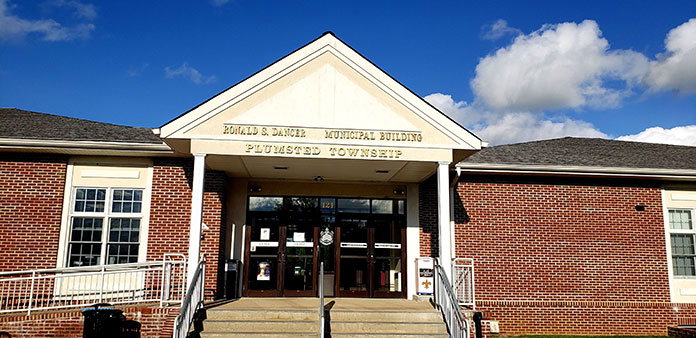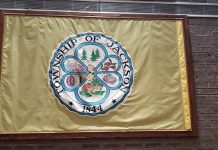
PLUMSTED – Two recent workshop meetings held at Town Hall had the purpose of gathering public input on a controversial ordinance that would expand the community’s C-4 Zone in downtown New Egypt but it also brought up issues of zoning within the community.
Mayor Dominick Cuozzo has hosted these sessions that have a slightly different format than a Township Committee meeting. He made a case for rezoning four lots on Main Street but residents who came out for those meetings aren’t convinced that this would be a positive move.
The lots in question are currently zoned as R-40, which is residential. Commercial businesses, single family homes and multifamily residences would be permitted in the C-4 zone. The mayor stressed that the meetings were scheduled to allow details of the ordinance to be better understood by the public, provide community input, and to show transparency.
“No action will be taken. This is about the purpose behind it and the problem we have in our town. Some of these things were discussed way back in August,” the mayor remarked.
The mayor’s remark referenced a contentious August committee meeting that was held in the middle of the afternoon. That session drew approximately 111 residents who loudly opposed the change, voicing that the concept behind it had not been properly discussed, was being introduced at an inappropriate time of day and that they wanted more details prior to its introduction.
While the mayor disagreed with that view, he joined the rest of the committee in voting it down and calling for a follow up meeting where the governing body would revise it for reintroduction.
Cuozzo said during the workshops that the current ordinance was simply a means to get the process moving forward. “This is something we are considering. Our town has a very serious situation. I think to really understand the problem you need to understand that the decisions made contributing to this problem were not made in the last six months or the last two years, these decisions were made decades ago.”
He referenced school district state aid funding losses through the state’s S-2 formula that drastically reduced funds for Plumsted by $7 million. This year when they were going over their budget paperwork, they had a decision to make – either cut more programs and more staff and teachers or balance their budget by voting to sell a portion of property that the school district owns.
“Their current school budget includes the sale of that property on Main Street,” he said.
The district wants to get the highest value when selling that property and requested the township rezone the land to C-4 so they could get a better price.
Rezoning that land by itself however, could be considered as spot zoning according to Township Attorney Jean Cipriani and that wouldn’t be permitted. Therefore, the idea came up to link that property with other lots along Main Street noting changes in the downtown redevelopment area.
“Now that we have a functioning sewer system, zoning options for the downtown redevelopment area have changed so we can have slightly more density, six residences per acre which is called the C-4 redevelopment zone,” Cuozzo said.
He said this would involve “areas that currently touch C-4 zoning” and that “all of these blocks that are being recommended already are touching and are adjacent to C-4 zoning and were brought up by myself as something we could consider to rezone.”
The mayor noted a second problem, which involves the Plumsted Township Municipal Utility Authority (PTMUA), which he said might soon be known for having “the highest utility cost in the state. That is where we are headed. We have a budget right now of approximately $1.3 million and a revenue stream of approximately $700,000.”
“That $1.3 million budget doesn’t include what it should for repairs and modifications that will be needed. We are approximately $600,000 in a deficit,” the mayor said. He warned that “every taxpayer of the town is going to subsidize that sewer system until it is solvent.” The PTMUA has just under 900 connections. He added that more than double the number of connections would we needed for the sewer system to approach solvency.
The mayor said, “we only have 3,000 residences in the whole town. For that to be more than double that means about 2,000 connections in order for the sewer system to become solvent.”
“We can sit back and literally do nothing about that and let the sewer system, like an albatross, drown the town in cost and expenses until we all run out of money and no one can pay their taxes. Instead of letting the overdevelopment of some developer who doesn’t have the best intentions of this town, we can – as a town – try to use our zoning to be smart about how we develop these things and we can consider doing some rezoning so we keep the developing there and we kill two birds with one stone,” Cuozzo added.
“We are planning for at least four meetings if we go forward with this,” the mayor added.
Sixteen residents offered comments and/or questions during that first session held on a Thursday afternoon.
Resident Carol Reed asked about whether there were any deed restrictions on the school property to which Cuozzo replied, “the school hasn’t listed the property for sale yet however a developer sent a letter to the school and in their proposal, it proposes buying the property from the school and in the process did offer the school other properties for recreational fields for larger or better than the school property.”
John Neyenhouse, who served for 10 years on the Land Use Board until the mayor removed him in January, had a number of questions and some comments. “There are a lot of things I think we need to be discussing as far as cons and pros with this.”
He noted that while Ocean County had initially rejected including the school property for its preservation program, “because it is a pseudo government agency that it is not even preserved through the natural lands there are at least eight other avenues that we are still working through for it to be potentially preserved.”
“A number of those look very promising still and it is not at a point where we need to say there is no option to preserve this,” Neyenhouse added.
“Rezoning it doesn’t take it off the table from being preserved. In fact rezoning it still makes the sale price to the preservation more valuable,” the mayor said.
Neyenhouse pointed out the workshop meetings were about changing the zoning for the property next to the school and that August’s Committee meeting featured a proposal to change “four entire blocks to C-4 zoning and it was basically the bulk of downtown and changing the existing residential zone and impacting residences by changing them.”
“Our town is probably the largest to receive farmland preservation. We have done an excellent job in preserving our farmland. The way they look at preservation programs they look at the best possible use value of the property,” Neyenhouse explained.
“At this point there really is no need to change the zoning on that but this really isn’t about the school property it’s about changing four entire blocks of property which would impact residential homes.”
“Single family homes, multi-family home use is permitted on these parcels,” Cuozzo loudly responded.
Neyenhouse said “there are currently protections people have as residential home owners that will go away if this changes. Maybe it is protected but I think that is something we need to understand as a community before we change zoning of people’s residences.”
The resident also noted the township’s redevelopment plan “was a mess right now” and that needed to be addressed. “We have developers coming into the Land Use Board and questioning redevelopment zones because there are multiple contradictions within the redevelopment zone.”
He said the Land Use Board and Environmental Committee has been trying “to clean up our zoning so it makes more sense” and that a redone redevelopment plan might serve to “remove some of this ambiguity.”
Neyenhouse also said that this needed to be addressed first “before we blanket change half of our downtown to a C-4 Zone when we aren’t confident of what that C-4 zoning is and what our redevelopment plan does for that.”






